
When an investigation has led to a reasonably complete description of the phenomenon under study and some of the antecedent conditions that might lead to differential outcomes are beginning to be understood, it then becomes interesting to design interventions that might modify such outcomes. In collaboration with Sherry Willis, who had previously designed and carried out a number of cognitive interventions as part of the Adult Development and Enrichment Project (ADEPT) at Pennsylvania State University (Baltes & Willis, 1982) and is currently a major investigator in the multisite Adult Cognitive Intervention Trial (ACTIVE; Ball et al., 2002; Willis et al., 2006), we explored how to best take advantage of a longitudinal study to advance the methodology of cognitive interventions in older adults (see also Schaie, 1996b; Stein-Morrow & Basak, 2011; Willis, 1987, 1990a, 1990b, 1992, 2001; Willis & Schaie, 1994b).
Over the past two decades, increased attention has been given in the study of adult intelligence to the question of modifiability of intellectual performance by cognitive training procedures (see Baltes & Lindenberger, 1988; Denney & Heidrich, 1990; Giambra & Arenberg, 1980; Stein-Morrow & Basak, 2011; Willis, 1985, 1987, 2001; Willis & Schaie, 1993). There has always been great interest in determining whether and how well old dogs can be taught new tricks. However, from the point of view of developmental theory and to determine the societal benefit of such interventions, it may be even more important to ask the question of whether cognitive interventions can result in the remediation of reliably documented age-related decline.
The theoretical importance of this question relates to the fact that, if it is possible to show that such decline can be reversed, then grave doubt is cast on the ten-ability of an irreversible decrement model of aging that assumes the inevitability of normative patterns of intellectual decline for all. Irreversible decrement models of cognitive aging also generally imply that observed behavioral deficits should be isomorphic with underlying adverse physiological age changes (cf. Baltes & Lindenberger, 1997; Botwinick, 1977; Kausler, 1982; Salthouse, 1982). A demonstration of the reversal of cognitive decline, on the contrary, lends greater plausibility to the hypothesis that behavioral deficit occurring with age is more likely to be caused by specific patterns of disuse and/or neuropathology. The remediation of cognitive decline in at least some individuals would also provide support for a hypothesis postulating behavioral plasticity through life (see Baltes, 1987; Baltes & Willis, 1977; Willis, Blieszner. & Baltes, 1981; Willis & Schaie, 2006b, 2009; Willis, Schaie, & Martin, 2009).
Important practical implications also follow the demonstration of successful remediation of cognitive decline. Older individuals are often institutionalized because their intellectual competence no longer suffices for them to function independently. Cognitive interventions, if effective in the laboratory, then can lead to the development of both generalized and specific educational intervention programs that could help restore the intellectual competence of many older individuals to levels that would maintain or prolong their ability to engage at an adequate level in tasks of daily living and thus to function independently within the community (see Willis, 1992, 1995, 2001).
Earlier cognitive training research strongly suggested that older adults’ performance can be modified on a number of cognitive dimensions, such as memory span, inductive reasoning, cognitive problem solving, spatial egocentrism, and so on (for reviews, see Baltes & Lindenberger, 1988; Denney, 1982; Poon, Walsh-Sweeney, & Fozard, 1980; Sterns & Sanders, 1980; Willis, 1985, 1987, 1989b, 1990a; Willis & Schaie, 1994b). Training effects have also previously been shown to generalize to multiple measures of the cognitive dimension on which training occurred (Baltes & Willis, 1982).
All of the training studies prior to the interventions conducted in the context of the Seattle Longitudinal Study (SLS), however, were cross-sectional in nature. These studies therefore could not reach any conclusions on whether the training gains represented remediation of prior cognitive decline or might represent the attainment of new performance levels (perhaps closer to the limits of their reserve capacities; see Baltes, 1993; Baltes, Dittmann-Kohli, & Kliegl, 1986) in individuals who had not experienced any cognitive decline. Obviously, addressing this distinction requires that the participants’ preintervention level of functioning must be compared with data collected at earlier times. Given the availability of participants in the SLS who had been followed over time, it seemed desirable to approach this question directly. There have been three cognitive training studies within the SLS: the initial training study (1983–1984); a 7-year follow-up of training maintenance, including a booster, and replication with a new sample (1990–1991); and a 14-year follow-up, booster, and a second replication with a new sample (1997–1998) (also see Saczynski, 2001).
We decided to restrict the training study to those participants for whom we had at least two previous data points to obtain sufficiently large samples of participants for whom we could reliably document decline. That is, we included only those study participants who at the time of the intervention had been followed for a minimum of 14 years and who in 1983 were at least 64 years old (SLS Cohorts 1 to 5). We also decided to train on the abilities of Inductive Reasoning and Spatial Orientation, for which average decline had been documented to occur by the early 60s (see chapter 5).
Including younger study participants or attempting to train on abilities such as Verbal Meaning, for which modal decline occurs at later ages, would have resulted in an insufficient number of participants who had reliably declined. Conversely, setting an older age cutoff would have reduced the number of stable individuals needed to contrast the effects of remediation of cognitive decline with improvement from a prior stable level of functioning (Schaie & Willis, 1986b; Willis & Schaie, 1986b, 1988).
The 1983–1984 training phase of the SLS included 228 participants (130 women, 98 men) who were born in 1920 or earlier and who had been SLS participants at least since 1970. Their mean age was 72.8 years (SD = 6.43; range = 64–85 years). Mean educational level was 13.9 years (SD = 2.90; range = 7–20 years). There were no sex differences in age or educational level. Mean income level was $19,879 (SD = $8,520; range = $1,000–$33,000). All of the participants were community dwelling, and most were white. Prior to initiating the study, each participant’s family physician was contacted and asked to indicate whether the participant suffered any known physical or mental disabilities that would interfere with study participation.
Participants’ test performances on the L. L. and T. G. Thurstone (1949) Primary Mental Abilities (PMA) Inductive Reasoning and Spatial Orientation measures were classified as having remained stable or as having declined over the 14-year interval from 1970 to pretest. The statistical criterion for the definition of decline was 1 standard error of measurement (SEM) or greater over the entire 14-year period (Reasoning = 4 points, Space = 6 points).1 Participants were classified by defining a 1-SEM confidence interval about their observed 1970 score (see Dudek, 1979). Participants who in 1984 were within the confidence interval about their 1970 score were classified as stables. Those who fell below the interval were classified as decliners.
There were 106 participants (46.5% of the sample) classified as having remained stable on both ability measures; 35 participants (15.4%) had declined on Reasoning, but not on Space; 37 participants (16.2%) had declined on Space, but not on Reasoning; and 50 participants (21.9%) had declined on both measures. As would be expected, stable participants (M = 70.9 years; SD = 5.35) were somewhat younger than decline participants (M = 74.4 years; SD = 6.84). Although the mean age differed significantly (p < .001), it is noteworthy that a wide range age range occurred for both stables (range = 64–85 years) and decliners (64–95 years). Decline and stable participants did not differ significantly on educational level or income.
At the base point used for classification (1970), there was no significant difference between participants who had been classified as stables or decliners on Space performance. However, those classified as declining on Reasoning performed, at base, significantly better (p < .02) than those who remained stable. Regression to the mean might therefore be a possible threat to the validity of the training study with respect to the Inductive Reasoning variable. However, the Reasoning measure has high internal consistency (L. L. Thurstone & Thurstone [1949] reported an r of .90 in their original studies) and long-term test-retest reliability of .80 or higher (Schaie, 1983a, 1985).
As an independent check of the plausibility of regression effects, we conducted a time-reversed control analysis (see Baltes, Nesselroade, Schaie, & Labouvie, 1972; Campbell & Stanley, 1963; Schaie & Willis, 1986b). Trace lines observed in this analysis were incompatible with the presence of substantial repression effects, and classification errors as specified by our criterion of plus or minus 1 SEM are therefore not significantly inflated.
Participants were assigned to either Inductive Reasoning or Spatial Orientation training programs based on their performance status. Those who had declined on Reasoning but not on Space or vice versa were assigned to the training program for the ability exhibiting decline. Participants who had remained stable on both abilities or had shown decline on both abilities were randomly assigned to one of the training programs. Spatial Orientation training participants included 50 stables (27 women, 23 men) and 66 decliners (37 women, 29 men). Inductive Reasoning training participants included 56 stables (31 women, 25 men) and 56 decliners (35 women, 21 men).
The study involved a pretest-treatment-posttest control group design. The Inductive Reasoning training group served as a treatment control for the Spatial Orientation training group and vice versa. Participants were administered the expanded battery described in chapter 3. Training began within 1 week of pretest and involved five 1-hour individually conducted training sessions. The training sessions were conducted within a 2-week period. The majority of participants were trained in their homes. Middle-aged persons with prior educational experience involving adults served as trainers. Participants were randomly assigned to the trainers within pragmatic constraints such that each trainer worked with approximately equal numbers of stable and decline participants in each training program. On completion of training, participants were assessed within 1 week on the same measures that were administered at pretest. They were paid $150 for participating in the study.
The focus of the training was on facilitating the participant’s use of effective cognitive strategies identified in previous research on the respective abilities. A content task analysis was conducted on the two PMA measures representing these abilities to identify relevant cognitive strategies.
For each item of the PMA Reasoning test, the pattern description rules used in problem solution were identified. Four major types of pattern description rules (identity, next, skip, and backward next) were identified and were a focus in training. These pattern description rules are similar to those discussed previously in the literature (Holzman, Pellegrino, & Glaser, 1982; Kotovsky & Simon, 1973; Simon & Kotovsky, 1963). Practice problems and exercises were developed based on these pattern description rules. Practice problems often involved content other than letters, so that the applicability of these rules to other content areas could be explored. For example, patterns of musical notes and travel schedules were devised based on these rules, and participants were asked to identify the next note or destination in the series. No training problems were identical in content to test items.
Participants were taught through modeling, feedback, and practice procedures to identify these pattern description rules. Three strategies for identifying the patterns were emphasized in training: visual scanning of the series, saying the series aloud to hear the letter pattern, and underlining repeated letters occurring throughout the series. Once a hypothesis regarding the pattern type was generated, participants were taught to mark repetitions of the pattern within the series and thus to determine the next item required to fit the pattern rule.
A content task analysis of the PMA Space test was conducted to identify the angle of rotation for each answer choice. Practice problems were developed to represent the angle of rotation identified in the task analysis (45°, 90°, 135°, and 180°). Cognitive strategies to facilitate mental rotation that were a focus in training included (a) development of concrete terms for various angles, (b) practice with manual rotation of figures prior to mental rotation, (c) practice with rotation of drawings of concrete familiar objects prior to the introduction of abstract figures, (d) participant-generated names for abstract figures, and (e) having the participant focus on two or more features of the figure during rotation. These cognitive strategies had been identified in prior descriptive research on mental rotation ability (Cooper, 1975; Cooper & Shepard, 1973; Egan, 1981; Kail, Pellegrino, & Carter, 1980).
We consider first training effects at the raw score level for the PMA Reasoning and Space tests because these are the measures for which longitudinal data were available and which served as the basis of participant classification. Second, training effects are examined at the latent construct level, that is, for the multiply marked ability factors on which training was conducted. Third, we note the proportion of participants whose decline was remediated as well as the proportion of stable participants who experienced significant improvement in functioning on the trained abilities. Fourth, we deal with the specificity of the training, that is, the question of whether the training effects were indeed directed to the target abilities or whether far transfer to other abilities occurred (see Thorndike & Woodworth, 1901). Fifth, we examine the question of whether training resulted in the remediation of losses in speed and/or accuracy. The question of whether training results in shifts in ability factor structure is further examined in chapter 8.
Training effects for the two measures with longitudinal data were analyzed with repeated measurement analyses of variance (ANOVAs), using a Training Condition (Reasoning, Space) × Status (Stable, Decline) × Gender × Occasion (Pretest, Posttest) design separately for the two tests (table 7.1). For PMA Reasoning, there were significant main effects for status (p < .001), gender (p < .01), and occasion (p < .001). The status and gender main effects reflect the lower scores on the target measure for decliners and men, respectively. The occasion main effect represents the retest effects occurring for both groups. With respect to the training effects of central concern, there was a significant Training × Occasion interaction (p < .001), indicating higher performance at posttest of those trained on Reasoning. There was a trend toward a significant fourfold interaction (p < .09). Post hoc tests on PMA Reasoning gain scores indicated that decliners showed greater gain than did stables. Gender and Gender × Status effects were not significant. When the Reasoning and Space training groups were compared, there were significantly greater Reasoning training effects for the target training group for stables (p < .001), decliners (p < .001), stable women (p < .002), and male and female decliners (p < .001).
TABLE 7.1. Summary of Analyses of Variance: Primary Mental Ability Raw Scores


For PMA Space, there were significant main effects for status (p < .001), gender (p < .02), and occasion (p < .001). The status and gender main effects reflect the lower scores of the decliners and women, respectively, across occasions. The occasion main effect indicates the retest effects occurring for both the Reasoning and Space training groups. As for the crucial results with respect to the training paradigm, there were significant interactions for Training × Occasion (p < .004) and for Training × Status × Occasion (p < .05). The Training × Occasion interaction indicated a significantly higher performance for the Space training group at posttest. The triple interaction with Status reflects greater training gain for the decliners at posttest. A significant Gender × Occasion interaction (p < .05) suggests the occurrence of larger retest effects for women. Post hoc tests on PMA Space gain scores indicated that there were significantly greater (p < .01) gains for decliners than for stables.
Figure 7.1 depicts the pretest–posttest gain computed from the standardized scores for the PMA Reasoning and Space tests for the four training subgroups (stable or decline on Reasoning, stable or decline on Space). Each set of bars in figure 7.1 compares the two subgroups trained on Reasoning with the two trained on Space; that is, each training group serves as a control for the other training condition.
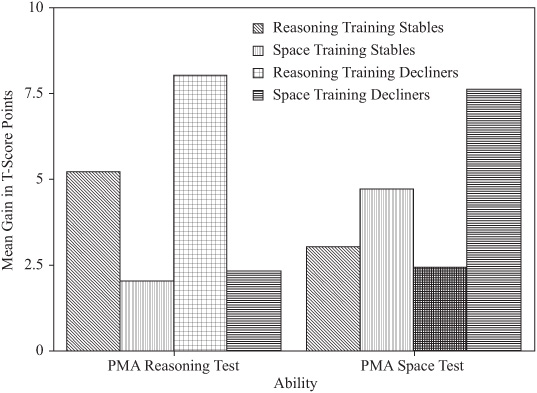
FIGURE 7.1. Pretest–posttest gain for four training subgroups (stable or decline on Reasoning, stable or decline on Space). PMA, Primary Mental Abilities.
The factor structure of the pretest ability battery was examined via confirmatory factor analyses. An acceptable five-factor model (χ2[243, N = 401] = 463.17, p < .01was obtained that represented the hypothesized primary mental ability factors of Inductive Reasoning, Spatial Orientation, Perceptual Speed, Verbal Ability, and Numeric Ability. All marker measures for Inductive Reasoning and Spatial Orientation, as predicted, had significant loadings on their respective factors. Regression weights (after orthonormal transformation) for tests loading on the Inductive Reasoning factor were as follows: PMA Reasoning = .378, ADEPT Letter Series = .213, Word Series = .298, Number Series = .111. Regression weights of tests loading on the Spatial Orientation factor were as follows: PMA Space = .260, Object Rotation = .393, Alphanumeric Rotation = .287, Cube Comparison = .060. Although the Number Series and Cube Comparison measures contributed relatively little variance to their respective factors, they were retained because they helped to obtain better definition of the factors within the broader ability space in which they were embedded. Factor scores were computed for the Inductive Reasoning and Spatial Orientation factors by standardizing (M = 50; SD = 10) the raw scores to the pretest base and then multiplying the standardized sores by their normalized regression weights.
Repeated measures ANOVAs were again performed separately on the Inductive Reasoning and Spatial Orientation factor scores using the same design applied to the PMA raw scores, that is, Training Condition (Reasoning, Space) × Status (Stable, Decline) × Gender × Occasion (Pretest, Posttest), as shown in table 7.2. For Inductive Reasoning, there were significant main effects for status (p < .001) and occasion (p < .001). The status and gender main effects reflect the lower scores of decliners and men, respectively. The occasion main effects represent the retest effects occurring for both training groups. Specifically relevant with regard to the effects of training was the significant Training × Occasion interaction (p < .001), indicating a significant training effect at posttest. No status, gender, or Gender × Status comparisons within the Reasoning training group were significant; hence, the training effect was general and not specific to status and/or gender.
TABLE 7.2. Summary of Analyses of Variance: Factor Scores


For Spatial Orientation, there were significant main effects for status (p < .001), gender (p < .01), and occasion (p < .001). The status and gender main effects reflect the lower scores of the decliners and women, respectively, across occasions. The occasion main effect indicates the retest effects occurring for both Reasoning and Space training groups. There were significant interactions for Training × Occasion (p < .02) and Training × Gender (p < .04). The Training × Occasion interaction indicated a significant training effect at posttest. The Training × Gender interaction indicates that overall performance on Space was higher for the target training group than for the controls for women only.
To exclude the possibility that regression effects might confound the results of the training study, we first examined the stability of our instruments over the interval between pretest and posttest by administering the measures over the same interval to a group of 172 participants of comparable age and socioeconomic status who did not receive any training. Test-retest reliabilities obtained in this study were .917 for the Space factor score and .939 for the Reasoning factor score. Retest reliabilities for the two PMA measures were .838 for Space and .886 for Reasoning. These estimates were next used to compute regressed deviation scores for our experimental participants (see Nunnally, 1982). The ANOVAs described above (see p. xxx) were then repeated on the adjusted scores. As would be expected in light of the high stabilities, resulting F-ratios differed only trivially, and none of the previously reported findings were significantly affected.
Because of slight differences between subgroups in terms of demographic characteristics, we also repeated the ANOVAs, covarying on age, education, and income. Again, effects of the covariance adjustments were trivial, and none of the findings reported above (see p. 201ff) were changed significantly.
The effects of cognitive training must be assessed in several ways. First, we need to know what proportion of participants showed significant gain from the intervention procedure. Next, we would like to know how successful the intervention was in remediating decline to an earlier—higher—level of functioning. Questions arise also as to whether training effects are specific to the targeted abilities or generalize to other abilities. Finally, it needs to be asked whether the training resulted in qualitative cognitive change.
The proportion of participants showing statistically reliable pretest–posttest training improvement on the PMA Reasoning or Space measure was computed. The statistical criterion for significant improvement was defined as a gain of plus or minus 1 SEM from pretest to posttest. The proportion of participants at the individual level with reliable training gain is shown in table 7.3. Approximately half the participants in each training group showed significant pretest–posttest improvement. Although there was a trend for a greater proportion of decline participants to show improvement in both training conditions, the difference between proportions was statistically significant only for the Space training group (p < .01).
TABLE 7.3. Proportion of Subjects Attaining Significant Pretest to Posttest Training Gain
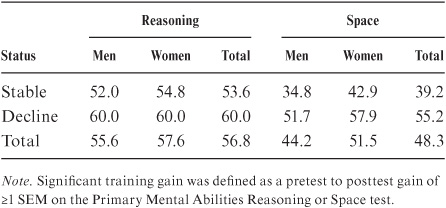
The question arises next as to what proportion of participants benefited from training sufficiently to result in a 14-year remediation to their 1970 base performance level. Two criterion levels were used to define remediation. The first level deemed remediation as having occurred when the difference between the participant’s PMA posttest score and the 1970 score was 1 SEM or less. This is the same statistical definition used in the first place to classify participants with respect to their 14-year decline. The second criterion level was even more conservative; it defined remediation as the attainment of a PMA posttest score that was equal to or greater than the 1970 base score.
Figure 7.2 presents the proportion of decline participants attaining these remediation criteria. Of the decline participants, 62% were remediated to their predecline level if the criterion of 1 SEM or more is used. In both training groups, more women were returned to their 1970 score level than were men. Using the more stringent criterion of return to the 1970 base level, approximately 40% of the decline sample was returned to the performance level it had exhibited 14 years earlier. Again, the proportion of participants whose decline was fully remediated was greater for women on Space and for men on Reasoning. Cognitive training gain also served as an important predictor of future mental status (Blaskewicz-Boron, Turiano, Willis, & Schaie, 2007).
The question arises next as to whether the training effects generalize across alternative measures of the same ability dimension (near transfer) or whether the intervention is so general that it affects performance on abilities not specifically targeted for training (far transfer). Near transfer is desirable because it offers evidence of convergent validity; far transfer is to be eschewed if we wish to modify ability-specific behaviors rather than obtain a Hawthorne effect that could be attributed simply to the intensive contact with our study participants.
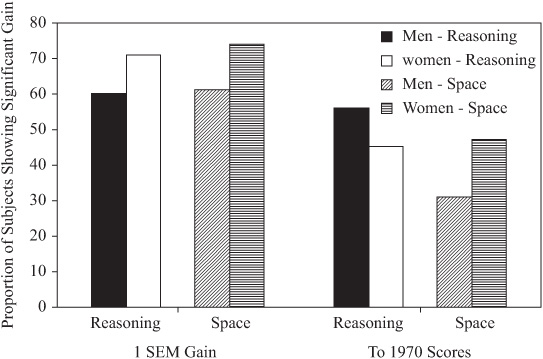
FIGURE 7.2. Proportion of decline participants attaining remediation criteria.
Strong near transfer was observed for those measures most similar to the longitudinal marker (Object and Alphanumeric Rotation for the Spatial Orientation factor; Letter Series and Word Series for the Inductive Reasoning factor). With respect to far transfer, we examined pretest–posttest gains for the two target abilities as well as the dimensions of Perceptual Speed, Numeric Ability, and Verbal Ability, which had not been targets for training. Figure 7.3 shows the far transfer pattern, which confirms our training specificity hypotheses. When factor score gains are averaged for two training groups on each of the five ability dimensions, we find that each training group has significantly greater gain on the ability on which it was trained, and that there are no differences on the abilities not targeted for training. Gains for the latter abilities represent retest effects and/or small, generalized training effects.
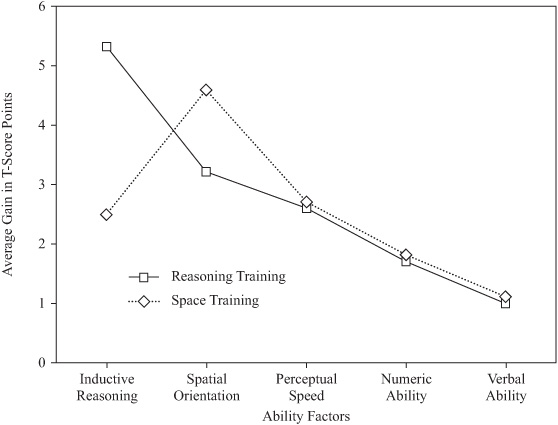
FIGURE 7.3. Far transfer pattern confirming the training specificity hypotheses.
Performance change over time and as the effect of training can be disaggregated into separate components that are caused by participants’ accuracy and speed. During the longitudinal preintervention phase, decline in accuracy may occur through disuse, and gain in accuracy during training may result from the reactivation of appropriate problem-solving strategies. We would expect a reduction in speed of performance with increasing age, but the intensive practice during the training phase might help to speed up participants’ response.
Change in accuracy for the preintervention and the pretest–posttest comparisons were obtained by the following procedures. An accuracy score was computed as the proportion of the attempted answer choices marked correctly (e.g., 1970 baseline rights/1970 items attempted). The expected accuracy score for the next test occasion was then computed, assuming that level of accuracy remained constant over the two occasions. For example, the 1984 expected score was computed as the proportion of 1970 correct responses multiplied by the 1984 number attempted. The change in accuracy then becomes the observed 1984 rights less the expected 1984 score. Subtracting the change in accuracy from the total observed score then yields the change in speed. The same procedure was used to decompose training gain, using the score of the 1984 observed rights to estimate the expected posttest accuracy score (see Blaskewicz-Boron, Willis, & Schaie, 2007; Willis & Schaie, 1988).
The average change in speed and accuracy from 1970 to 1984 is depicted on the left-hand side of figures 7.4 and 7.5 for Inductive Reasoning and Spatial Orientation, respectively. Because there were no significant gender differences in patterns of accuracy and speed, figure 7.4 shows change for the stable and decline participants. On Spatial Orientation, there was a significant Gender × Stability condition interaction. Data are therefore presented separately by gender and stability condition.
The 14-year decline on Inductive Reasoning can be apportioned about equally to speed and accuracy. For the stable group, a small loss in accuracy is partially compensated for by a gain in speed. No gender difference in composition of change is observed.
On Spatial Orientation, there is no significant gender difference for the entire group in the magnitude of total decline. However, a significant gender difference is found for the speed change score (p < .03). A greater proportion of the total decline of the men is attributable to a decrease in problem-solving speed. For the stable participants, men remained stable by compensating for a slight loss in speed by a commensurate increase in accuracy. Stable women showed a slight gain in both speed and accuracy. For the decline participants, men lost primarily in speed, whereas women declined approximately equally in both speed and accuracy.
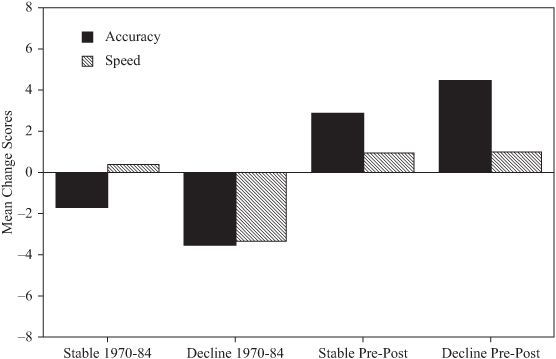
FIGURE 7.4. Changes in speed and accuracy from 1970 to 1984 and for the training gain for Inductive Reasoning by stability condition.
The right-hand side of figures 7.4 and 7.5 shows training gain decomposed into speed and accuracy in the same manner as for the longitudinal change. For Inductive Reasoning, most of the training gain was accounted for by increased accuracy; only minimal gain in speed was found. This pattern is equally true for those who declined and those who remained stable. Note, however, that the decliners recovered virtually all their loss in accuracy. No gender difference in training gain pattern was found.
On Spatial Orientation, by contrast, there is a significant gender difference in favor of women for total training gain (p < .03). Gain for the stable subgroup was primarily because of an increase in problem-solving speed, and there was no gender difference for this subgroup. The gender difference appears only in the decline group. Here, men show gain in accuracy but not in speed, whereas gain for the women is approximately equal for speed and accuracy.
To assess the replicability of our training effects with additional samples, we also trained an additional 179 participants in 1990–1991 and an additional 190 participants in 1997–1998. All of these new trainees met the original selection criteria but had not been trained previously (Saczynski, 2001; Saczynski, Willis, & Schaie, 2002).
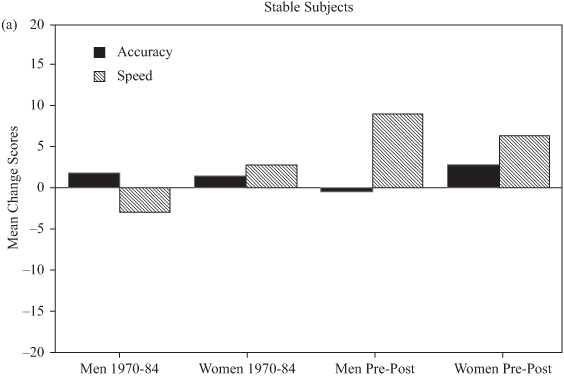
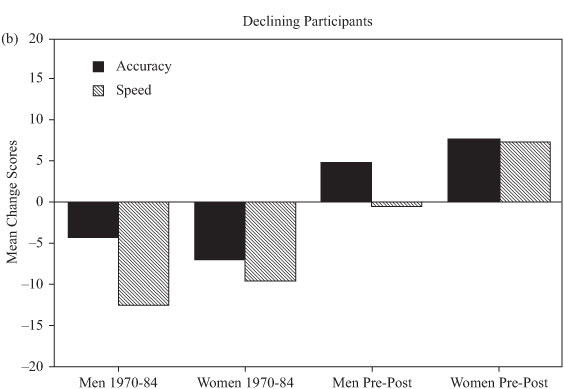
FIGURE 7.5. Changes in speed and accuracy from 1970 to 1984 and for the training gain for Spatial Orientation by stability condition and gender.
Participants in the three replicates were compared to determine whether there were differences in age, education, or pretest ability. Repeated measures of analysis of covariance results for PMA Reasoning (N = 586) and Space (N = 588) measures as well as Inductive Reasoning (N = 571) and Spatial Orientation (N = 586) were made at the factor level. Age and education were entered as covariates. The first sample had lower education than the subsequent samples (1984 = 13.91, 1991 = 14.48, 1998 = 14.75 years). No significant differences between groups were noted in age and pretest performance levels.
Analyses of the replications of the first-time training suggest that significant training effects and near transfer to alternate operational forms of the target tests can be repeatedly demonstrated. Significant effects of training in excess of pretest–posttest practice can be demonstrated as well at the latent variable level. We also replicated the finding of stronger training effects observed for Inductive Reasoning than for Spatial Orientation. In addition, we controlled for the significant covariates of age, education, and occasion by age. Table 7.4 provides the complete ANCOVA results for the factor scores across the three replicates. Figure 7.6 compares training gains under the different training conditions for the three replicates in 1983–1984, 1990–1991, and 1997–1998 for Spatial Orientation; the differences in gain between training and control groups remain quite constant over the three replicates.
TABLE 7.4. Repeated Measures Analysis of Covariance for the Training Replication Covaried for Age and Education
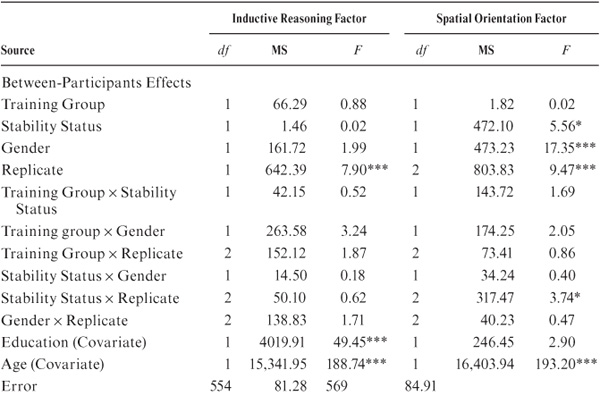
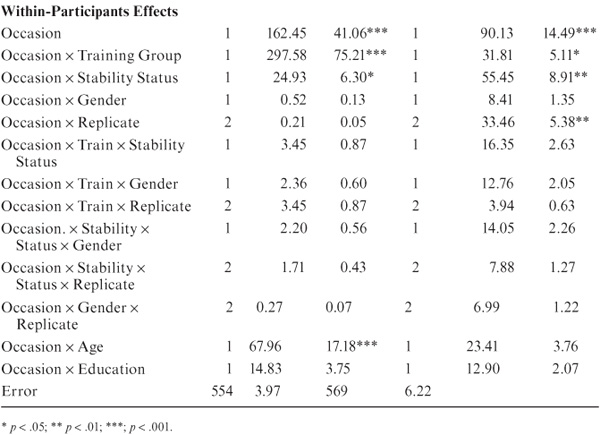
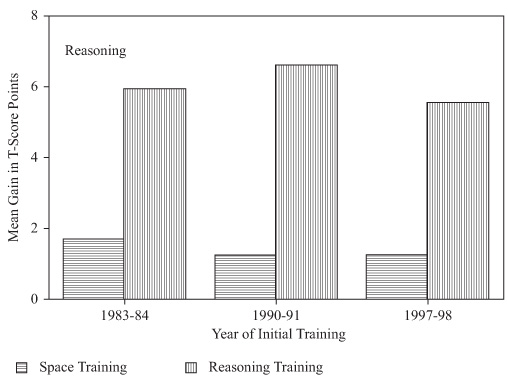
FIGURE 7.6. Replicated training gain for intervention and control groups.
The question remains as to whether the effects of cognitive interventions such as ours do provide benefits that last over extended periods of time and whether it is possible to remediate further losses that occur as study participants move into advanced old age. To address these questions, the 1991 cycle included a 7-year follow-up of the original training study (see Willis & Schaie, 1992, 1994b). In 1998, we also followed a second sample over 7 years. Finally, a small sample was followed from 1984 to 1991. This section presents data that bear directly on the question of maintaining and sustaining cognitive training effects. Specifically, the question whether persons receiving brief cognitive training remain at an advantage compared with those not so trained is addressed. Second, the effects of booster training to determine the benefits of further reactivation of the abilities trained earlier are considered.
All study participants who participated in the 1983–1984 training and who were known to be alive in 1990 were contacted. There were 148 trained participants who agreed to participate in the follow-up study. Of these, a total of 140 were able to complete the follow-up testing, and 132 participants received booster training. Their ages in 1990–1991 averaged 77.74 years (SD = 4.98; range = 71–92 years).
All participants were assigned to the same training condition they had been assigned for the initial training: Spatial Orientation decliners (10 men, 24 women), as well as 75 Inductive Reasoning training participants, including 45 stables (17 men, 28 women) and 30 decliners (12 men, 18 women).
The pretest–posttest design of the original training study was replicated as exactly as possible. The booster training was given for the same ability (Inductive Reasoning or Spatial Orientation) for which participants had originally been trained. Participants were assessed within 1 week of training on the same measures that were administered at pretest. They were paid $150 for participating in the study.
Findings from the follow-up study are reported in three parts. First, the magnitude of the initial training for the surviving sample and the nature of attrition effects are described. Second, the maintenance of training over 7 years is considered; that is, the question of whether persons receiving brief cognitive training remain at a long-term advantage over those not so trained is addressed. Third, the effects of sustaining training effects by booster training to determine the benefits of further reactivation of the abilities trained earlier are reported. For simplicity in presentation, the longitudinal markers that were applied throughout the SLS are emphasized.
During the 1983–1984 training study, significant training effects were obtained for both abilities trained. Because of attrition of approximately 40% in the follow-up studies, we recomputed training effects for the surviving sample. Overall, there was a gain of approximately 0.5 SD in each training program. These effects continue to be significantly greater than those for the comparison control group. However, contrary to findings in the unattrited sample, there was significantly greater effect for those participants who had been identified as decliners (see figure 7.7). These results reflect greater retention of those of the decline participants who showed significant training gain in the initial training. There was an interaction effect in retention for the stable participants. Those with greater training gain on Space also showed higher retention, but those with greater training gain on Reasoning showed lower retention.
We next consider the extent to which training gains are retained after 7 years. In 1990–1991, participants trained in 1983–1984 were functioning, on average, at their 1983–1984 pretest level on the trained ability. In contrast, the comparison group (those trained on the other ability) was functioning significantly below its 1983–1984 pretest level. As shown in figure 7.8, there was a significant maintenance of function on the trained ability even after a 7-year interval. For the total group, this was a modest effect, amounting to approximately 0.3 SD. Again, however, this effect was most pronounced for those participants who had been classified as decliners for purposes of the initial training. For both abilities, these individuals, on average, still performed above their 1983–1984 pretest level, whereas their comparisons had declined further. The trained groups of decliners in 1990–1991 had an advantage of approximately 0.4 SD over their comparison groups. By contrast, those who had been stable in 1983–1984 were at an advantage of approximately 0.15 SD over their comparisons on Reasoning. The difference between the stable experimental and control groups on Space was not statistically significant.
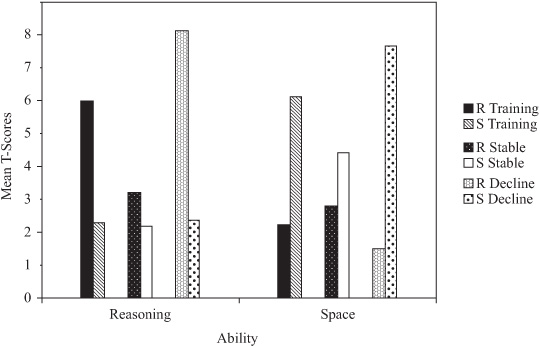
FIGURE 7.7. Gain at initial 1983–1984 training for the group returning for follow-up training. R, Reasoning; S, Space.
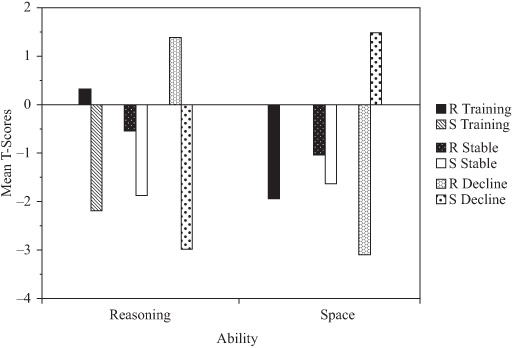
FIGURE 7.8. Maintenance of training effects over 7 years. R, Reasoning; S, Space.
When the previously trained participants were again put through the same training regimen they had experienced earlier, significant ability-specific training effects were obtained for both training conditions as well as for the subsets of participants who had been classified as having declined or remaining stable at initial training. That is, in all instances, gains from pretest to posttest were significantly larger than for the untrained comparison groups. However, the effects of the 1990–1991 booster training were of a somewhat lower magnitude in these participants, who were 7 years older.
Of particular interest is the question of cumulative magnitude of initial and booster training when participants are compared with control groups who had the same amount of attention (by training on another ability). As shown in figure 7.9, there is a clear advantage for those participants who were originally identified as experiencing decline. After booster training, they are at an advantage of better than 0.5 SD over their comparison groups. The training advantage for those participants described as stable at initial training is more equivocal. It is still highly significant for Reasoning, although their advantage is more modest, but there is no significant cumulative advantage for stable participants who were trained on Space.
To show the generality of the follow-up findings beyond the prime longitudinal marker, we also computed factor scores across each set of four markers of the abilities on which we trained. Figure 7.10 shows that the cumulative training effects at the latent construct level were quite similar to those shown in figure 7.9.
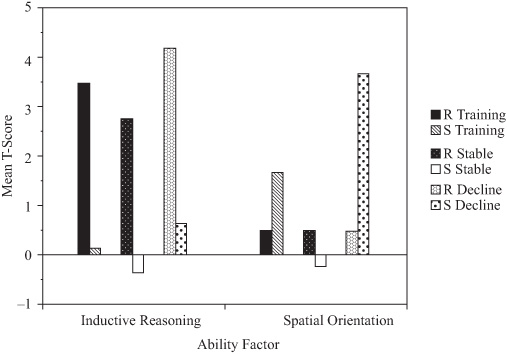
FIGURE 7.9. Cumulative training effects over two training periods for the principal marker variables. R, Reasoning; S, Space.
To examine the generalizability of the 7-year maintenance findings, recent analyses that expand the analysis of maintenance by growth curve modeling over the period beginning 14 years prior to training to the pretest for the 7-year follow-up are reported (Saczynski et al., 2002).
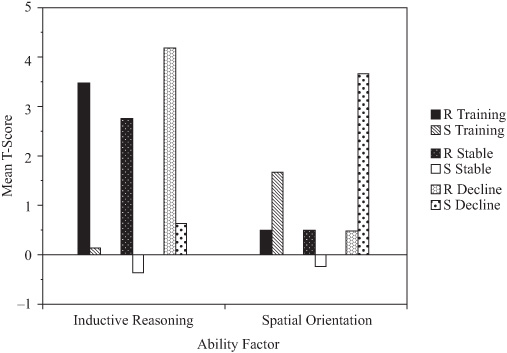
FIGURE 7.10. Cumulative training effects over two training periods for the principal marker variables. R, Reasoning; S, Space.
The maintenance replication sample included all participants initially trained in 1984 and 1991 who were available for follow-up 7 years later (1991 or 1998, respectively). This subsample consisted of 210 participants (140 in 1984, 70 in 1991). Mean age at initial training was 70.2 years (SD = 4.79; range = 64–85 years). Mean educational level of this subsample was 14.3 years (SD = 2.76; range = 7–20 years).
An attrition analysis was conducted to determine if the total maintenance sample (N = 210) differed significantly from the total initial training sample (N = 408) with respect to age, education, and income. The follow-up subsample on average was about 2 years younger than the initial sample but did not differ on education or income. However, the follow-up sample had a significantly higher pretest performance at initial training than the total sample; that is, it was higher by 0.24 SD on Space and by 0.32 SD on Reasoning.
Growth curve modeling was used to estimate parameters over a maximum of 21 years involving both training and booster interventions. Three intervals were examined: pretraining (Time 1 to Pre 1), initial training (Pre 1 to Post 1), and 7-year maintenance (Post 1 to Pre 2). Multiple group models were fit to compare participants in the Inductive Reasoning and Spatial Orientation training groups. To examine the initial training and maintenance intervals, piecewise growth models were fit to permit evaluation of multiple data trends (Bryk & Raudenbush, 1992).
Although the training groups did not differ on either ability at baseline, there was a significant difference in rate of change between the two groups. For both abilities, participants in the training target group showed steeper rates of decline over the pretraining period than the comparison participants training on the other ability. This difference, of course, was a direct function of the assignment strategy.
The initial training growth models, as hypothesized, showed a significantly steeper rate for the target training compared with the other training group. Lower education, higher Motor-Cognitive Flexibility, and faster Psychomotor Speed were associated with greater training gain.
With respect to the 7-year maintenance period, it was found that there was no significant decline on the Reasoning measures for those participants training on this ability. By contrast, individuals in the Space training group did decline significantly on the Reasoning ability. On the other hand, both training groups declined significantly on Spatial ability. No covariates were identified that predicted individual differences in rate of change during the maintenance period.
Reexamination of the baseline through 7-year maintenance interval by growth curve modeling confirms successful initial training for both training groups but indicates that the long-term training effect is limited to the Reasoning training with respect to reducing the rate of further decline. Figure 7.11 shows the accepted fit for the piecewise growth curve model from baseline to 7-year follow-up.
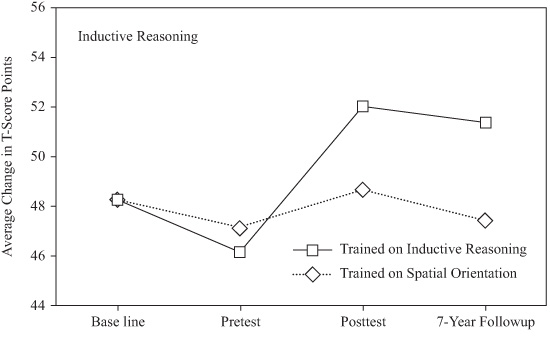
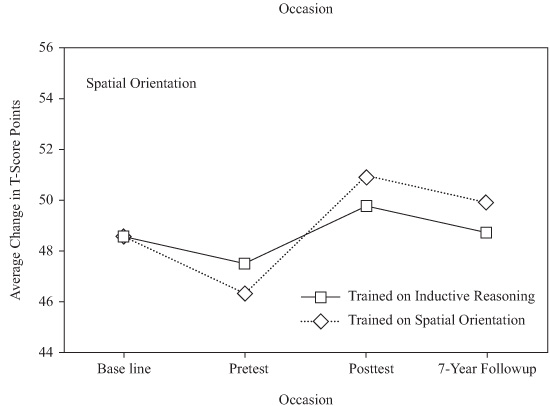
FIGURE 7.11. Piecewise growth curve models from baseline (14 years prior to training) to 7-year follow-up.
To determine whether benefits would still remain after 14 years, we conducted another follow-up of the 1984 training study as part of the 1998 cycle. Specifically, we addressed the question of whether persons receiving brief cognitive training remain at an advantage compared with those not so trained over a 14-year period, particularly if booster training is used for further reactivation of the abilities trained earlier.
All study participants who participated in the 1990–1991 training and who were known to be alive in 1997 were contacted. There were 67 trained participants who were able to complete the follow-up testing and who received booster training. Their ages in 1997–1998 averaged 82.93 years (SD = 4.07; range = 78–96 years).
All participants were assigned to the same classification they had in 1990–1991. The surviving participants consisted of 33 Spatial Orientation participants (9 men, 24 women) and 34 Inductive Reasoning training participants (13 men, 21 women). Education and age for the attrited sample did not differ significantly from those found for the total training group in 1984.
The pretest–posttest design of the original training study was replicated as exactly as possible. The booster training was given on the same ability (Inductive Reasoning or Spatial Orientation) for which participants had originally been trained. Participants were assessed within 1 week of training on the same measures that were administered at pretest. They were again paid $150 for participating in the study.
ANOVA was used to test hypotheses with respect to the combined training and maintenance design. Training Groups (2) × Occasions (6) repeated measures ANOVAs were conducted separately for the two dependent variables, followed by Tukey’s HSD (honestly significant difference) post hoc tests for unequal cell sizes.
The overall change within participants over the six-occasion effect was highly significant (p < .001). Post hoc tests also showed significant gains for each training intervention and significant 7-year declines over the intervals between the successive interventions (p < .001). However, the overall differences between the first pretest and the final posttest were not significant (p > .05), suggesting overall maintenance of performance level as a consequence of the interventions.
Of greater concern, however, is the question of whether the observed maintenance of performance level is because of a 5-hour training program every 7 years starting with the late 60s or whether the effect is specific to the targeted training. Our findings suggest the latter interpretation because we observed significant Training Group × Occasion interactions (p < .001).
Post hoc tests indicated that there was maintenance for the Inductive Reasoning training group over the 14 years from first pretest to last posttest on the targeted ability but not on the other ability. However, the Spatial Orientation training group, although it did slightly better on Spatial Orientation, did show significant decline over 14 years despite the intervention (see figure 7.12).
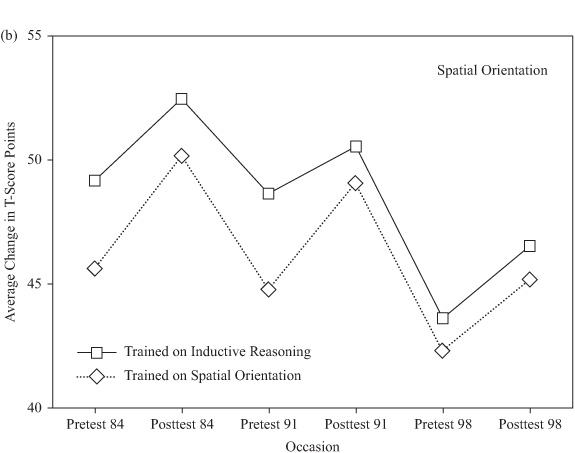
FIGURE 7.12. Fourteen-year training effects from first pretest to last posttest
In our efforts to understand better the mechanisms involved in obtaining improved performance through cognitive training, we investigated the role of strategy use in reasoning training with older adults (Saczynski et al., 2002). Our argument in this context was the hypothesis that the content of cognitive training interventions is largely concerned with reactivating or training participants in the use of systematic strategies to solve problems (Diehl & Willis, 2003; Willis, 2001; Willis & Nesselroade, 1990).
In the study reported next, two questions were addressed: First, we asked whether increase in strategy use differed from pretest to posttest. Second, we were interested in identifying participant characteristics that might be associated with strategy use and would predict training gain on the latent construct of Inductive Reasoning.
The subsample included 393 older adults (177 males, 216 females) who received their initial cognitive training in either 1984 or 1991. Mean age of the total sub-sample was 72.9 years (SD = 6.41; range = 64–95 years). Mean educational level was 14.1 years (SD = 3.05; range = 7–20 years). There were no significant age or educational differences between participants entering training in 1984 or 1991.
Classification and assignment to Space or Reasoning training as well as training procedures and measures used to evaluate training success have been described earlier in this chapter (on pp. xxx). As part of the instructions, participants were encouraged to make pencil marks on test materials to help them determine serial patterns.
The pretest and posttest protocols for the ADEPT Letter Series and the Word Series tests were coded for strategy use. Three strategies were coded: (a) slashes between repeats in patterns, (b) tick marks between skipped letters or words, and (c) underlining of repeated letters or numbers in a series. A minimum of two “strategy marks” was required for an item to be identified as representing strategy use. Coders who were blinded to the training group membership of participants achieved an interrater reliability of .87.
Repeated measures analyses of covariance examined the effects of two training groups (Reasoning, Spatial Orientation) by two genders by decline status (stable, decline) by two replicates (1984, 1991) by three age groups (64–70, 71–77, and 78–85 years). The dependent variables were pretest and posttest strategy use. Education entered the analyses as a covariate. Hierarchical regression was used to determine the association between increased strategy use, demographic variables, and training gain.
For the Letter Series test, a significant occasion-by-training interaction indicated significantly greater increase in strategy use after training for the target training group than for the Space training group (p < .001). In addition, well-educated participants, regardless of training group membership, showed greater increase in strategy than those with lower educational exposure. We also found that the youngest age group showed greater increase in strategy use than did the two older groups. No higher-order interactions proved statistically significant. Similar findings were obtained with respect to the Word Series test.
The weighted average of all four reasoning measures (see p. 204 ff) was used to define the latent dependent variable. Strategy use was then averaged across the two coded measures at pretest and posttest, and the interaction between training group and change in strategy use after training was entered as the first step of a hierarchical regression equation. Demographic variables (age, gender, and education) were entered in a second step. A third step added the interactions between change in strategy use and the demographic variables as well as reasoning decline status and change in strategy use.
The first step in the hierarchical regression yielded an R2 of .204. Significant predictors of posttest gain on the Inductive Reasoning latent construct included the interaction between increase in strategy use and training group, indicating that participants who were trained on reasoning and who showed increase in strategy use also had greater training gain. Pretraining decline on the reasoning ability also turned out to be an independent significant predictor of training gain.
TABLE 7.5. Hierarchical Regression Analysis for Variables Predicting Training Gain on the Inductive Reasoning Factor
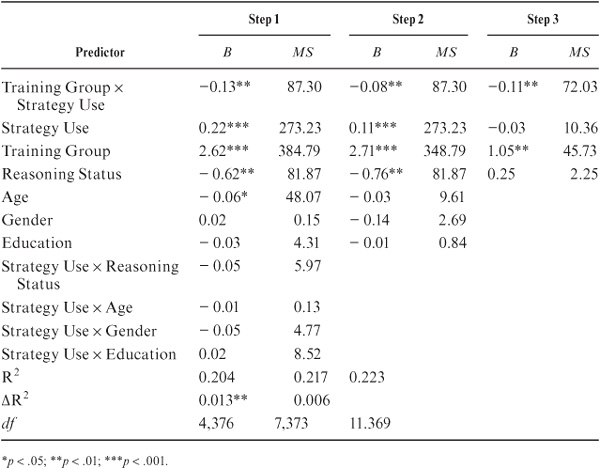
The second step significantly increased R2 to .217. The gain was confined to the greater posttest gain showed by younger participants. No additional increase in predictive power was obtained by the third step (see table 7.5).
The findings from this study suggest that there is indeed a significant role for strategy-based training in increasing training gains in cognitive interventions (cf. Verhaeghen & Marcoen, 1996). The role of strategy use was somewhat more important in the young-old than in the older group but did not differ across educational level or decline status.
Our cognitive intervention studies allowed us to conclude that, for many persons, cognitive decline in old age may be a function of disuse rather than deterioration of the physiological substrates of cognitive behavior. A brief 5-hour training program involving individual tutorials was designed to improve the performance of participants above the age of 64 years on the abilities of Inductive Reasoning and Spatial Orientation. Participants were assigned either to training in the ability on which they had declined or randomly to one of the two training conditions if they had declined or remained stable on both abilities.
The training program used in the initial training studies succeeded in improving the performance of about two thirds of the participants. More important, of those participants for whom significant decrement had been documented, roughly 40% were returned to the level at which they had functioned 14 years earlier. Training effects were shown for the single marker for which longitudinal data were available, as well as near transfer to additional markers, indicating training improvement at the latent construct level. No far transfer was observed, demonstrating both convergent and divergent validity for the training procedures. Results of the initial training were confirmed in two replications 7 and 14 years later. Magnitudes of training effects in the replications equaled those obtained in the initial study.
Follow-up studies of cognitive training after 7- and 14-year intervals, furthermore, demonstrated that participants who prior to initial training had shown significant decline remained at substantial advantage over untrained comparison groups. Booster training increased the advantage of these groups further. Over 14 years, trained individuals, on average, showed maintenance from the first pretest to the last posttest on Inductive Reasoning and lower decline than the comparison group on Spatial Orientation. Long-term effects for those who had remained stable at initial training differed by ability. More modest, but significant, effects were shown to prevail on Inductive Reasoning but not on Space training.
Studies of the role of strategy use in training success revealed increased use of strategies for those who gained from training, but also indicated that the young-old and those with higher levels of education were most likely to use strategies in their performance.
Findings from the training study suggest that targeted cognitive intervention programs can reverse the modest age-related decline that is likely to be related to disuse of certain cognitive skills. Booster applications of these techniques, moreover, result in reduction of age-related declines on the trained abilities. Wider applications of similar interventions may well be useful in retaining independent living status for older persons who might otherwise be institutionalized because of marginal cognitive competence.